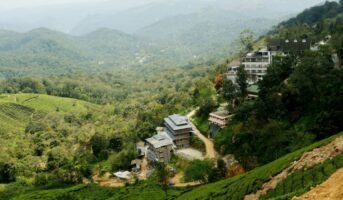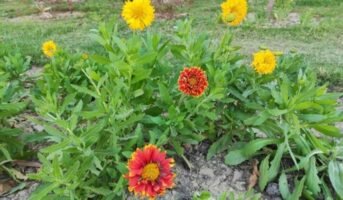Amritsar in Punjab is often regarded as one of the most spiritually significant cities in India. Traditions, religious practice, and cultural expression come together in Amritsar in a way that can only be described as magnificent. Amritsar is the place to go if you want to get a taste of the warm hospitality and friendly atmosphere that can be found across the state of Punjab.
Amritsar is a thriving tourist attraction due to the presence of many factors, including fascinating legends, religious buildings, ancient edifices, busy bazaars, colourful festivals, and mouthwatering cuisine. Rest assured, you will never run out of things to do in Amritsar.
How To Reach Amritsar
By air: The Sri Guru Ram Das Jee International Airport in Amritsar, which is about 11 kilometres from the city centre, offers more than 150+ domestic and international flights each day. Daily direct flights are available from Delhi, Mumbai, Kuala Lumpur, Doha, London, etc.
By train: The Amritsar Railway Station provides connections for the city to almost all of the important cities such as Delhi, Ahmedabad, Mumbai, Hyderabad, Agra & Kolkata. It takes around six hours to reach Amritsar from Delhi by rail.
By road: Because it is situated on the National Highway 1, Amritsar has excellent road access. There are daily bus services to and from Ambala, Patiala, Delhi, Chandigarh, and Jammu. These services are conducted by both public and private companies. You can hire rickshaws or taxis to go about the city.
Are you prepared to discover the mystique of Amritsar? Make the most of your time in this well-liked city by checking our recommendations on Amritsar tourist places.
20 best places to visit in Amritsar to make the most of your trip
Golden Temple

Source: Pinterest
The Golden Temple (The Sri Harmandir Sahib Amritsar), often known as the “Crown Jewel of Amritsar”, is undoubtedly the city’s most popular tourist destination and is among India’s top 10 most frequented tourist destinations. The temple is an excellent example of traditional Sikh architecture. The Gurudwara dates back to the 16th century, is built at a lower level than the surrounding terrain, and serves as a symbol of equality and humility. This sacred shrine has four doors, one in each cardinal direction, to demonstrate that visitors from all walks of life are accepted and respected without distinction.
Sri Harmandir Sahib Amritsar is home to the biggest communal kitchen in the world, which allows anybody to sit on the floor and have food (langar) with other people who are also visiting the site. It is breathtaking to see armies of volunteers cutting onions, peeling giant cloves of garlic, and preparing dal, kheer, sabzi and roti for as many as one hundred thousand people each day.
Timings: 4 am – 11 pm
Time needed: 2 – 4 hours
Entry fee: Nil
Gurudwara Baba Atal Rai

Source: Pinterest
Within the compound that houses the Golden Temple in Amritsar is where you’ll find Gurudwara Baba Atal Rai. This revered place of worship was erected in memory of Baba Atal Rai, the son of Guru Har Gobind Singh. Atal Rai was just 9 years old when he passed away, thus each of the nine floors of the octagonal tower commemorates one year of his life.
This architectural masterpiece is one of the most popular tourist destinations in Punjab, attracting millions of pilgrims each year. The last floor of the tower provides a bird’s eye perspective over the busy city of Amritsar. It’s more than simply a reminder of Baba Atal Rai’s heavenly power, it’s also a symbol of the majesty and splendour of Indian culture.
Timings: 7:30 am – 7:30 pm
Time needed: 1 – 2 hours
Entry fee: Nil
Akal Takht

Source: Pinterest
The Akal Takht, also known as the Throne of the Timeless One, is the most important political and administrative organisation in the Sikh religion. It was established in 1606 by Guru Hargobind, the sixth Sikh Guru. The Akal Takht is one of the Five Takhts that the Sikhs consider most holy, and it can be seen in Amritsar’s well-known Golden Temple complex.
These Takhts are the centres of power and authority within the Sikh community. They are also the dwellings of the Jathedar, who are considered to be their most senior speakers. The Akal Takht is intended to be a symbol of political sovereignty and justice. It is also a place where the issues of the Sikh people, both spiritual and worldly, can be addressed and discussed.
Timings: 4 am – 11 pm
Time needed: 30 – 60 mins
Entry fee: Nil
Ram Bagh Gardens

Source: Pinterest
The Ram Bagh Summer Palace was erected during the reign of Maharaja Ranjit Singh. It was finished in 1831 and was given its current name in honour of Guru Ram Das, the fourth Sikh guru, who is credited with founding the city of Amritsar. The Shalimar Garden, which was built in Lahore by Emperor Shah Jahan served as the inspiration for the design of Ram Bagh.
The red-stone structure with two stories and scalloped entrances creates a feeling of place because of its inlaid marble flooring, charming balconies, and scalloped doorways. Both the palace and the other structures within the Ram Bagh complex are considered to be important national monuments, making the whole complex a protected state landmark.
Timings: 10 am – 5 pm
Time needed: 1-2 hours
Entry fee: Free for gardens, Rs 10 for museum
Durgiana Temple

Source: Pinterest
The Durgiana Temple in Amritsar, also known as the Lakshmi Narayan Temple due to its more common name, is one of the most visited locations in the city and is dedicated to the goddess Durga. The statue of the Hindu goddess Durga provided inspiration for the naming of the temple. Idols of Goddess Lakshmi, commonly known as the “Goddess of Wealth,” and Lord Vishnu known as the “ Protector of the World” can be found nearby.
Timings: 6 am – 10 pm
Time needed: 1 hour
Entry fee: Nil
Mata Lal Devi Temple

Source: Pinterest
The Mata Lal Devi Mandir is a holy Hindu temple and is a one-of-a-kind site of devotion. Mata Lal Devi was a female saint who lived in the 20th century, and this shrine is dedicated to her. In contrast to other temples, this one has brightly coloured corridors lined with mirrors, streams that are only knee-deep, winding passageways, tunnels, and even a cave. The fact that the temple is home to a large number of Hindu deities, as well as a variety of grottoes and shrines, is an intriguing aspect of the building..
Timings: 5 am – 11 pm
Time needed: 1-2 hour
Entry fee: Nil
Bhagwan Valmiki Tirath Sthal

Source: Pinterest
11 kilometres west of Amritsar, on the Amritsar Lopoke road, lies the Bhagwan Valmiki Tirath Asthan, dedicated to Maharishi Valmiki. According to legendary accounts, the temple goes back to the time of the Ramayana, and the area is renowned for the ashram of the sage Maharishi Valmiki. It is the location where the sage sheltered Sita, Rama’s wife, after she was abandoned following the Lanka Conquest.
The idol of Valmiki is the most popular feature of this temple complex. It is a breathtaking sight to witness since it is 8 feet in height and is covered with about 800 kg of gold. In addition, there is a holy water tank, a communal hall that can accommodate up to 5,000 worshippers, a library with Sanskrit writings, and an instructive museum for visitors to explore.
Khairuddin Mosque

Source: Pinterest
The Khairuddin Mosque was constructed by Muhammad Khairuddin around 150 years ago, and it is a great example of Islamic architecture. The imposing building is green on the outside and white on the inside, and it has three domes, four minarets, and beautiful artwork on its walls.
Timings: 6 am – 10 pm
Time needed: 30-60 minutes
Entry fee: Nil
Wagah Border

Source: Pinterest
The Wagah Border, which separates India and Pakistan along the Grand Trunk Road, is 28 kilometres from Amritsar. The Wagah Border Ceremony, also known as the Beating Retreat Ceremony, takes place each day just before the sun goes down and is the most popular event. At this particular border station, the Indian and Pakistani armed forces get together at the end of each day for a camaraderie-building and showmanship-filled performance that lasts for almost half an hour right before nightfall.
The Wagah Border is undoubtedly one of the best Amritsar places to visit. During this ceremony, the international gates are closed, and both nations’ flags are lowered. Since 1959, the Indian Border Security Force and the Pakistan Rangers have been the ones to preside over the ceremonial raising and lowering of the flag. The audience participates in activities such as singing the national anthem of India, giving rounds of applause, and dancing in a Bollywood style to Hindi music.
Timings : 10 am- 4 pm
Time needed: 2-4 hours
Entry fee: Nil
Entry & Seating: First-come-first-served basis
Ceremony timings: 5:15 pm- Summers, 4:15 pm- Winters
Jallianwala Bagh

Source: Pinterest
When talking about Amritsar famous places, Jallianwala Bagh is at the top of the list. It is a historical garden and a “monument of national importance” relatively close to the Golden Temple. It was established in remembrance of those who were wounded or perished in the Jallianwala Bagh Massacre, which took place on the 13th of April 1919. As people gathered for a joyous celebration of Baisakhi, General Dyer issued orders that resulted in the deaths of thousands of innocent people.
Timings: 6:30 am – 7:30 pm
Time needed: 1-2 hours
Entry fee: Nil
Gobindgarh Fort

Source: Pinterest
One of the most historically significant tourist sites in Amritsar is the Gobindgarh Fort, which can be found right in the middle of the city. Before it was opened to the general public in 2017, the fort was under the command of the Indian Army and was reserved only for its use by the military.
The Gobindgarh Fort is now being transformed into a combination of an art gallery and a living museum. The location will play host to some of the most ancient Sikhism-related artwork and manuscripts. Additionally, the well-known Zamzama Cannons can be seen inside Gobindgarh Fort.
Timings: 10 am – 10 pm (daily)
Time needed: 4-5 Hours
Entry fee: Different events, attractions, and rides cost from Rs 180 to Rs 649 for Indians.
Maharaja Ranjit Singh Museum

Source: Pinterest
Want to learn about the first Sikh emperor? This is the place to visit. After being the first Indian in a millennium to stop the Pashtuns (Afghans) from invading India again, Ranjit Singh was renowned as the Sher-e-Punjab (Lion of Punjab). The museum is home to a multitude of collections that provide insight into the myriad of possessions that belonged to the emperor.
The key highlights of this museum include paintings, coins, and manuscripts, among other things, all of which provide a clear picture of the living conditions and travels of the Sikh emperor. People come from all over the globe to learn about the life of the emperor and how he became such a well-known name in Amritsar.
Timings: 10 am – 5 pm (Tuesday To Sunday)
Time needed: 1-3 Hours
Entry fee: Free for children below 5, Rs 20 for children of 5 years & above, Rs 40 for adults
Partition Museum

Source: Pinterest
The Partition Museum in Amritsar is the only institution in the world that is exclusively dedicated to the historical event known as the Partition. Visitors to Amritsar can get insight into this seminal period by visiting the museum. It includes a frightening collection of newspaper clippings, vintage pictures, and oral histories of persons who experienced the bloodshed that led up to the split of the two nations, as well as the resettling of refugees after the event.
The museum will provide you with a more in-depth comprehension of the reasons for the competition that exists between India and Pakistan. As you leave the museum, scribble a message down on a piece of green paper and then put it on the Tree of Hope.
Timings: 10 am -6 pm (Tuesday To Sunday)
Time needed: 1-3 Hours
Entry fee: Free for partition survivors & children below 5, Rs 10 for children of 5 years & adults, Rs 250 for foreigners
Punjab State War Heroes Memorial and Museum

Source: Pinterest
The Punjab State War Heroes Memorial and Museum displays the heroic bravehearts of Punjab throughout the museum with patriotic fervour. Featuring both traditional and contemporary design elements, it is home to a cutting-edge exhibition showcasing the rich martial history of Punjab and its many military engagements. Tourists can retrace their footsteps via a plethora of images, pictures, paintings, artefacts, weaponry, and interactive displays.
For travellers who want to get a glimpse of the Wagah border’s famous Beating Retreat ritual, this museum is a great place to begin their trip to India. The 45-meter stainless steel sword in the centre of this interesting exhibition is its main attraction. The sword is a symbol of the people’s power and bravery during conflict.
Timings: 10 am – 5 pm
Time needed: 1-3 hours
Entry fee: Rs 100 per person
Katra Jaimal Singh Bazaar

Source: Pinterest
The Katra Jaimal Singh Market is widely regarded as being among the finest markets in all of Amritsar. Find yourself in the middle of a labyrinth of bustling streets that are crammed with shops, restaurants, and food stalls. Admire the storefront windows that are painted in a kaleidoscope of colours and watch as eager salespeople negotiate with consumers. This market is well-known for the wide variety of clothes outlets that it has.
Katra Jaimal Singh Bazaar is easily accessible on foot from a number of the most popular destinations in the city. The bazaar is around 10 minutes from the Golden Temple, Durgiana Temple, and Jallianwala Bagh. You can continue your shopping adventure in Amritsar in the adjacent Hall Bazar, which is a well-known bazaar for handicrafts, jewellery, and home décor. Although some of the stores in the Katra Jaimal Singh Market are closed on Sundays, the market itself is open every day.
Hall Bazaar

Source: Pinterest
Take a stroll through Gandhi Gate and go to Hall Bazaar, the city’s most popular souvenir shop. This market, which is in the middle of the city between the Golden Temple and the Partition Museum, is claimed to be one of the oldest in India. Whether you’re looking for the latest technology, phulkari needlework, bangles, local handicrafts, traditional clothes, or Chinese lamps, this historic market is the place to go.
If you find that you are becoming hungry while you are shopping, you may stop at one of the many food vendors that are located throughout the market. The Bade Bhai ka Brothers Dhaba is quickly becoming one of the most frequented restaurants in the area for travellers who want to try some traditional Punjabi food served in thalis. At Pehelwan Amritsari Fish Shop or Bheeri Gali wali Dukan, you can savour fish cooked to perfection or luscious curried meats. Both of these restaurants are located in Bheeri Gali.
Kesar Da Dhaba

Source: Pinterest
Your exciting tour of Amritsar will not be complete until you indulge in some of the city’s best laccha parathas at one of the city’s most traditional eateries. Kesar Da Dhaba is a century-old Dhaba that serves some of the tastiest Punjabi food anywhere, including dishes that are doused in Desi ghee and are particularly rich in flavour.
There was a period when well-known figures, such as Lala Lajpat Rai, would often stop by the Dhaba. Both Pandit Jawahar Lal Nehru and Indra Gandhi were known to receive food packages from this location. It is highly recommended that you finish your meal or supper with the scrumptious phirni that is served in clay bowls at this establishment. Chowk Passian, Shastri Market, is where the restaurant is situated. Add this timeless dhaba when you are preparing your list of must-visit tourist places in Amritsar.
Sadda Pind

Source: Pinterest
Sadda Pind offers a unique opportunity to immerse yourself in the vibrant colours and mouth-watering flavours of Punjabi culture. Sadda Pind has something for everyone in its diverse array of offerings. The young may re-establish ties with their ancestors and get a deeper appreciation for the customs and values they inherited from them. The elderly often have fond memories of simpler periods in their lives. Tourists from across the world may get a taste of rural Indian life in its purest form. Visitors from different states may get a taste of authentic Punjabi culture at a single location.
One of the best places to visit near Amritsar, Sadda Pind is spread out across a large area of land of 12 acres, this location provides tourists with the room to investigate everything that the traditional Punjabi culture has to offer. You have the option of mastering a time-honoured art form or coming up with your own unique masterpiece. Traditional arts such as phulkari, Punjabi jutti, clay toys and utensils, ironwork, durries, and agricultural equipment are some examples of work that can be found here.
Timings: 10:30 am – 10 pm
Time needed: 3-5 hours
Entry fee: Rs 700 per adult
Harike Bird Sanctuary

Source: Pinterest
The Harike bird sanctuary is a must-see if you want to visit Amritsar. One of the best places near Amritsar to visit, the sanctuary is a haven for bird lovers and welcomes thousands of migrating birds every winter. Some of these species fly all the way from Siberia and the Arctic to spend the season here. It provides protection for a great variety of birds, both those who stay year-round and those that migrate. During the height of the migratory season, Harike Bird Sanctuary plays host to around 45,000 ducks.
The Indus dolphin, which was thought to have become extinct in India after 1930 but is still widely found in the Indus River system, was recently spotted in the Beas River in the Harike wetland area. This species of aquatic mammal is considered to be endangered in the wild. Indus dolphins are essentially blind as a result of having evolved to live in the murky river environment. They use echolocation to explore, communicate, and hunt food such as prawns, catfish, and carp.
Timings: 10 am – 6 pm
Time needed: 1-4 hours
Entry fee: Nil
Khalsa College

Source: Pinterest
Amritsar visiting places know no end. If you have an interest in architecture, you shouldn’t miss the opportunity to check out Khalsa College, which is located on Grand Trunk Road in Amritsar. The ancient educational institution also serves as a notable example of Indo-Saracenic architecture, which is a mash-up of Western European aesthetics with the exuberance of Indian and Persian forms. Khalsa College dates back to the 19th century.
The magnificent main structure of Khalsa College, which is known as the “Palace,” has been featured in many Bollywood movies due to its eye-catching onion domes and scalloped archways. Spend some time strolling the peaceful campus and grounds, but bear in mind that the academic and administrative buildings are off-limits to anybody save students and staff members since the institution is still in operation.
Timings: 9 am – 6 pm
Time needed: 30-90 minutes
Entry fee: Nil
FAQs
Who should travel to Amritsar?
Amritsar is an excellent location for both holidaymakers and pilgrims. Several pre-independence sites are of tremendous historical value. It also includes stunning religious sites and temples.
What is the ideal time of year to visit Amritsar?
The ideal time to visit Amritsar is from September to December and from February to March, when the weather is nice and conducive to touring. January temperatures stay around 5°C, but May and June are the hottest months of the year, with temperatures reaching 40°C.
Are two days in Amritsar enough?
If you have two days in Amritsar, you'll have plenty of time to see the city's historical and religious landmarks.
What food is famous in Amritsar?
Amritsar is home to some of the country's best, richest, and most delectable cuisine. It's hard to go wrong with Amritsari Kulcha and Lassi; Amritsari Fish; Amritsari Chicken Tikka; Tandoori Chicken; and a piping hot Gulab Jamun.
What can I buy in Amritsar?
From Amritsar, you buy the finest shawls and carpets, electronics, phulkari embroidered work textiles, shoes, saris and Chinese lamps, as well as dried fruits and artificial jewellery. Among the excellent items to purchase in Amritsar are woollen clothes, sweaters, and Pashmina shawls.
| Got any questions or point of view on our article? We would love to hear from you. Write to our Editor-in-Chief Jhumur Ghosh at [email protected] |
Nisha A Rawat, diligently tracks the residential real estate trends and offers valuable insights in her articles. She’s skilled at making real estate terminology easy to understand, ensuring accessibility for all. Nisha’s articles are well-researched and analytical.











